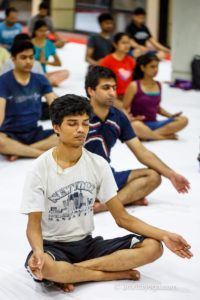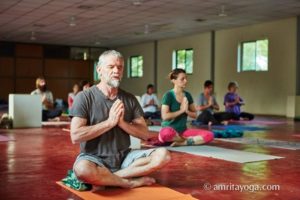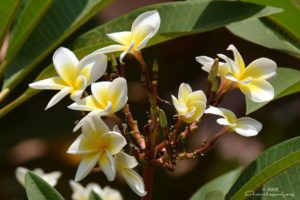(Editor’s Introduction: In this satsang (spiritual discourse), Swamiji Amritageetananda Puri, one of Amma’s most senior disciples, discusses the importance of following a prescribed sadhana (spiritual practice). Because each sadhak (spiritual aspirant) is unique, there are different sadhanas that are beneficial for each person. Only a Sadguru like Amma knows what is best for each individual.
Swami especially makes a distinction between the path of knowledge (“jnana”) for the meditative type and the path of action (“karma”) for the active type. It is important we ask our Guru what sadhanas are best for us. Once we do, we need to have full faith and trust that this is the best sadhana for us to reach our goal of Self-Realization.)
The Meditative & The Active
 “What can I do for Amma?” is a question often asked by many devotees. It is heartening to hear this question from the devotees. Generally, people think only of what they can get instead of what they can give. We hear the word “go-getter,” referring to a person who is smart enough to get whatever he/she wants wherever he/she goes. “What can I give?” is a question that comes from a mature and evolved person.
“What can I do for Amma?” is a question often asked by many devotees. It is heartening to hear this question from the devotees. Generally, people think only of what they can get instead of what they can give. We hear the word “go-getter,” referring to a person who is smart enough to get whatever he/she wants wherever he/she goes. “What can I give?” is a question that comes from a mature and evolved person.
“What should be my sadhana or spiritual practices?” is another question that is asked by many devotees. The answer to this question has to come directly from our Guru, Amma. The sadhana that Amma prescribes for Her sadhak (spiritual aspirant) children may vary from person to person. Only Amma knows what sadhana can purify a sadhak and remove his /her inherent negative tendencies and prarabdha (the results of negative actions in the past) – meditation, mantra japa (repetition of mantra or sacred syllables), archana (worship), bhajans (devotional singing), seva (selfless service), charity, etc. These are the many sadhanas.
Here is a piece of beautiful advice describing what should be done by whom:
Dhanavantham atha adhaanam
Nirdhanam cha athapasvinam,
Ubhau Ambasi Mokthavyau
Galey badhvaa Mahaashilaam!
This means that a rich person’s sadhana is charity, and a person with less money needs to do only tapas (austerities).
 “A rich person who does not do charity and a person devoid of riches who does not perform austerities – both should be thrown into the sea with a big stone tied round their necks” (not to be taken literally, but meaning they each are not living in accordance with their duties and dharmic principles).
“A rich person who does not do charity and a person devoid of riches who does not perform austerities – both should be thrown into the sea with a big stone tied round their necks” (not to be taken literally, but meaning they each are not living in accordance with their duties and dharmic principles).
The implied meaning is that the spiritual practice for a rich man is charity and for a poorer man is tapas (austerity). The poor man need not grieve that he has no money for charity. The above verse hints that the two types who don’t perform their respective duties are not following dharmic principles.
What type of tapas I should do depends on what type of person I am and what type of mind and body I have. All sadhanas are important for all sadhaks, but the proportion varies from sadhak to sadhak. It is very important to go to one’s Guru to know what the best sadhanas are.
When we look at devotees, including ourselves, we see that they can be broadly divided into two – the meditative type and the active type. In the beginning of the 3rd chapter of Bhagavad Githa, Bhagavan tells Arjuna,
Lokesmin Dvividhaa Nishtaa
Pura Proktha Mayaa Anagha,
Jnanayogena Saankhyaanam,
Karma Yogena, Yoginaam.
 “There are two types of path in this world taught by Me in the past – the path of knowledge for the meditative type and the path of action for the active type.”
“There are two types of path in this world taught by Me in the past – the path of knowledge for the meditative type and the path of action for the active type.”
We have to note here that Bhagavan says, “Dvividhaa Nishtaa,” or two types of path (singular) and not paths (plural). It only means that Jnana Yoga and Karma Yoga are two stages of the same path. Karma Yoga comes first, bringing about purification, steadiness, and concentration of mind. Then comes Jnana Yoga – through which one realises his or her innate nature as Divine Consciousness.
We have to understand that our main sadhana to reach our human goal is dhyanam (meditation), which leads to jnanam – knowing our real nature as Divine Consciousness. All other sadhanas like mantra japa, archana, etc., are supporting sadhanas.
There are two types of ignorant people who find it difficult to reach their goal. The first type are those people who go straight to jnana marga (path of knowledge) without first going to karma marga (path of action). They make very little or no progress as their impure minds have not been purified by karma (action). The other types are those who are stuck with karma and refuse to go to jnana marga. They sink deeper into bondage. Therefore, the right method is first coming to Karma Yoga and then to Jnana Yoga. Only those who have performed sufficient karmas will have the mental purity for deep meditation. And again, only those who deeply meditate can be efficient in performing actions that bring positive results. Therefore, Jnana Yoga and Karma Yoga are complimentary.
“Every soul is potentially Divine,” said Swami Vivekananda. Our Guru, Amma, is the only power that can take us into the deepest part of ourselves and merge us into our Divine nature.
 There are many valuable lessons that we learn from our Sadguru, Amma. Generally, people give a lot of importance to human effort or self-effort, ignoring Divine Grace. But a true sadhaka, as he/she progresses more and more in spiritual life, realises that Divine Grace alone takes him/her closer to the goal and even self-effort is not possible without Divine Grace.
There are many valuable lessons that we learn from our Sadguru, Amma. Generally, people give a lot of importance to human effort or self-effort, ignoring Divine Grace. But a true sadhaka, as he/she progresses more and more in spiritual life, realises that Divine Grace alone takes him/her closer to the goal and even self-effort is not possible without Divine Grace.
The sadhana prescribed for us by our Guru is like medicine and proper diet. We stick to the medicine and diet prescribed for us by our doctor. Unfortunately, nowadays we see devotees getting upset thinking that their Guru has given more to others and less to themselves! This is erroneous thinking. If Amma has given me more of japa and dhyanam and less of karma, let me spend my time well with japa and dhyanam!
I had a very amusing experience a few years back. A devotee told me, “Swamiji, Amma has not understood my capabilities and efficiency; She has given me very little responsibility! The devotee was unhappy about it. He wanted more activities and responsibilities. By Amma’s Grace I somehow managed to convince him that Amma is all-knowing and She alone knows what is best for him. Other types of devotees are those who complain, “My Guru has given me too much karma (action). I am not able to meditate like some others who have more time!” This is also erroneous thinking.
 What my Guru has given me as my sadhana is the best for me and my spiritual growth. In the early days of my Ashram life, I was taking classes for the ashramites and also feeding the cows! If I am allowed to choose my own sadhana, I will only strengthen my personal likes and dislikes. This results in sinking deeper into bondage. A wise disciple never says, “Guruji, I don’t want this. I want only that!” She/he will only say, “Guruji, whatever you choose for me is the best for me!” The Dakshinamurthy stotram speaks about the Guru thus:
What my Guru has given me as my sadhana is the best for me and my spiritual growth. In the early days of my Ashram life, I was taking classes for the ashramites and also feeding the cows! If I am allowed to choose my own sadhana, I will only strengthen my personal likes and dislikes. This results in sinking deeper into bondage. A wise disciple never says, “Guruji, I don’t want this. I want only that!” She/he will only say, “Guruji, whatever you choose for me is the best for me!” The Dakshinamurthy stotram speaks about the Guru thus:
Nidhaye Sarva Vidyanam,
Bishaje Bhava Roginaam
Gurave Sarva lokaanaam,
Dakshinamurthaye Namah!
It means, “I bow to Dakshinmurthy who is the wealth of all knowledge (the real wealth to be gained by all knowledge), who is the doctor who cures the disease of bondage and suffering, who is the Guru of all worlds!”
See how the Guru is described as
Bhishaje Bhava Roginam
 The Guru is the doctor who cures the patients who are suffering from the disease of bondage and suffering! The Guru is our doctor. We go to our doctor and tell him what our problem is – he alone decides and prescribes the medicine!
The Guru is the doctor who cures the patients who are suffering from the disease of bondage and suffering! The Guru is our doctor. We go to our doctor and tell him what our problem is – he alone decides and prescribes the medicine!
And this doctor called Guru is Divine, all-knowing
Nidhaye Sarva Vidyaanaam
He never makes a mistake neither in His diagonosis nor His prescriptions of medicine.
We, children of Amma, pray to Her to give us the purity of mind and clarity of vision to understand our Guru Amma. We pray for Her to bless us so that we may grow in faith and devotion for Her. May we never feel that the spiritual practices prescribed by Her are a burden to us, but a joyful journey towards our goal of Human Life:
Poorna Brahma Swarupinyai
Sachidananda Murthaye
Atmarama Agraganyayai
Amriteswaryai Namo Namah
Adorations to Amma, the immortal Goddess who is the complete manifestation of absolute Truth.
Who is existence, consciousness, knowledge and bliss embodied.
Who is supreme among those who revel in the Inner Self.
Swami Amritageetananda Puri
(As always, thoughtful comments are invited and appreciated. Share your reflections with us! See below to leave a comment.)

0 Comments